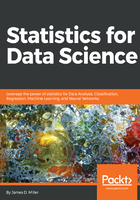
What this book covers
Chapter 1: Transitioning from Data Developer to Data Scientist, sets the stage for the transition from data developer to data scientist. You will understand the difference between a developer mindset versus a data scientist mindset, the important difference between the two, and how to transition into thinking like a data scientist.
Chapter 2: Declaring the Objectives, introduces and explains (from a developer’s perspective) the basic objectives behind statistics for data science and introduces you to the important terms and keys that are used in the field of data science.
Chapter 3: A Developer's Approach to Data Cleaning, discusses how a developer might understand and approach the topic of data cleaning using common statistical methods.
Chapter 4: Data Mining and the Database Developer, introduces the developer to mining data using R. You will understand what data mining is, why it is important, and feel comfortable using R for the most common statistical data mining methods: dimensional reduction, frequent patterns, and sequences.
Chapter 5: Statistical Analysis for the Database Developer, discusses the difference between data analysis or summarization and statistical data analysis and will follow the steps for successful statistical analysis of data, describe the nature of data, explore the relationships presented in data, create a summarization model from data, prove the validity of a model, and employ predictive analytics on a developed model.
Chapter 6: Database Progression to Database Regression, sets out to define statistical regression concepts and outline how a developer might use regression for simple forecasting and prediction within a typical data development project.
Chapter 7: Regularization for Database Improvement, introduces the developer to the idea of statistical regularization to improve data models. You will review what statistical regularization is, why it is important, and various statistical regularization methods.
Chapter 8: Data Development and Assessment, covers the idea of data model assessment and using statistics for assessment. You will understand what statistical assessment is, why it is important, and use R for statistical assessment.
Chapter 9: Databases and Neural Networks, defines the neural network model and draws from a developer’s knowledge of data models to help understand the purpose and use of neural networks in data science.
Chapter 10: Boosting and your Database, introduces the idea of using statistical boosting to better understand data in a database.
Chapter 11: Database Classification using Support Vector Machines, uses developer terminologies to define an SVM, identify various applications for its use and walks through an example of using a simple SVM to classify data in a database
Chapter 12: Database Structures and Machine Learning, aims to provide an explanation of the types of machine learning and shows the developer how to use machine learning processes to understand database mappings and identify patterns within the data.